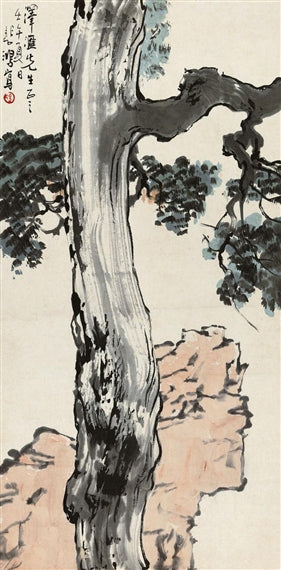Description
The painting "Gran Pino" (1942) by Xu Beihong immerses us in the universe of traditional Chinese painting and at the same time reveals the mastery of an artist who knew how to merge oriental and western elements in his work. Xu Beihong, a central figure of Chinese modern art, was committed to the renewal of Chinese painting by incorporating Western techniques, without abandoning the roots of their own culture. This work is a clear example of that harmonious balance that he managed to achieve.
The "great pine" receives us with its majesty. The composition of the work focuses on this tree that, with its lushness and its robust trunk, seems to stand as a landscape guardian. Xu Beihong presents it with realism and precision that shows its domain of the technique. The pine branches extend with a wavy and natural movement, a detail that reflects the thorough attention of the artist by the tree anatomy. These elements are executed with a firm line that, although apparently simple, denotes a great skill and control of the brush.
The use of color is another remarkable aspect in this painting. Xu Beihong uses different tones of green and brown to give life to the pine, creating a feeling of depth and volume that invites the observer to explore every corner of the work. The choice of a limited palette, focused on dark and green -green tones, manages to transmit the serenity and internal force of the pine, symbolic characteristics that are often attributed to it in Chinese culture.
As for the historical context, it is interesting to note that this work was carried out in 1942, a period of great tumult for China in the middle of the Sin-Japanese war. In this sense, pine could be interpreted as a symbol of resistance and strength, reflecting not only the force of nature, but also the resilience of the Chinese people in the face of adversity. Xu Beihong's ability to capture this resilient spirit in such a seemingly simple work demonstrates his talent not only as a painter, but also as a visual narrator.
A particular characteristic of the work is the lack of human characters, which is not atypical in traditional Chinese painting, where natural elements often occupy the leading role. However, the pine in itself has an almost anthropomorphic presence, as if Xu Beihong had infused human life and emotions. This technique of imbuiting natural objects with human qualities is a tradition in Chinese art that Xu Beihong handles with a mastery.
To better understand the importance of this work, it is crucial to contextualize it within the broader corpus of Xu Beihong's work. Known for their horses representations, which symbolize energy and vitality, and their paintings Of birds, the "great pine" might seem a deviation from its usual theme. However, this work remains consistent with its concern about vital force and technical skill. The same meticulousness and energy present in their horses can be perceived in the branches and needles of the pine.
In conclusion, "Gran Pino" (1942) is a work that encapsulates the technical mastery and symbolic depth of Xu Beihong. Through his pine study, the artist not only presents a detailed portrait of nature, but also offers meditation on resistance and strength in times of difficulty. In doing so, Xu Beihong reaffirms its place in art history as a bridge between Eastern traditions and Western innovations, creating a work that continues to resonate with force and relevance in the contemporary artistic landscape.
KUADROS ©, a famous paint on your wall.
Hand-made oil painting reproductions, with the quality of professional artists and the distinctive seal of KUADROS ©.
Art reproduction service with satisfaction guarantee. If you are not completely satisfied with the replica of your painting, we refund your money 100%.

